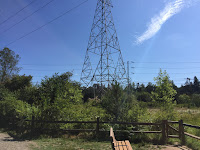Type of Event: Study Tour
Topic: Urban forest park and habitat restoration
Organization: Tualatin Hills Nature Park
Location: Beaverton, Oregon
Host: F. Scott Wagner, Park Ranger, Tualatin Hills Park & Recreation District
International Fellows: Abiodun Solanke (Nigeria), Adam Wasiak (Poland), Andrea Cornejo (Nicaragua), Ana de Miguel (Spain), Karishmaa Pai (India), Yu Lei (China), Samantha Kwan (Malaysia)
WFI Staff: Shadia Duery / International Fellowship Manager, Michael Zhan / Intern from China
On this day, we went on a study tour to the Tualatin Hills Nature Park located in Beaverton, Oregon.
 The main objective of this study tour was to learn about restoration
strategies for an urban forest park. During our visit, we also learned
about wetland mitigation, trail building and corridor habitat
improvement.
The main objective of this study tour was to learn about restoration
strategies for an urban forest park. During our visit, we also learned
about wetland mitigation, trail building and corridor habitat
improvement.This 220-acre urban park covered with evergreen deciduous forests, wetlands and meadows represents a high value habitat for wildlife. This park is a great example of how an island type of forest habitat can be reconnected and restored with adjacent land to create wildlife migration corridors.
Restoration sites:
- Tadpole Pond
- Enhanced five tadpole ponds and surrounding area
- Improved habitat for the red-legged frog, Rana aurora, a species listed in Oregon Department of Fish and Wildlife's Sensitive Species List
 |
| Red-legged frog |
- Westside Trail
- Most of the Westside Trail will be within the power transmission corridor controlled by Bonneville Power Administration and Portland General Electric
- The power corridor establishes a continuous open space that supports wildlife habitat & movements
 |
| Adjacent power line corridor |
- The Creek Trail
- Bioswale built at the back of Tri-Met garage to pre-treat runoff before it reaches Tualatin's wetlands
- More than 8,000 native plants and trees were planted and the Creek Trail was rerouted and improved
Take home messages:-
When restoring habitat in an urban forest, it is important to:
- Focus on providing viable habitat for target species or group of species that have declining populations due to habitat degradation
- Take into consideration the several end users of the resource when crafting a management plan: i.e. people and wildlife
- Restoration is best paired with education (reconnecting people to nature)
- Engage with adjacent stakeholders to prioritize balance between infrastructure development / pressure and natural integrity
International Fellow’s Reflection:
Samantha Kwan from Malaysia - Habitat restoration in urban forest |
| OPH pair of PNR |
- Island forest in an urban setting
- Same area (220-acres)
- Restoration projects to enhance habitat connectivity for the Oriental Pied Hornbill (OPH)
- Challenges: urban development and wildlife movement
I especially liked the red-legged frog habitat restoration project. Because reconnecting the frog habitat will also help other flora and fauna as well. In PNR, the OPH is used as the restoration umbrella
species. Restoring their habitat will contribute to the resilience and viability of other wildlife
populations.
 | ||
| Aerial photo of Tualatin Hills Nature Park, Beaverton, OR and Piasau Nature Reserve, Miri, Sarawak |
Disclaimer: This video is ©SARAWAK FORESTRY ALL RIGHTS RESERVED
No comments:
Post a Comment